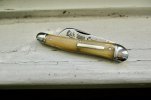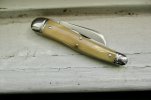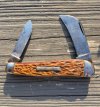Old Hunter
Gold Member
- Joined
- Jul 12, 2012
- Messages
- 10,115
Bryon, wonderful collection, the antique yellow bone seems right at home with you. OH
The BladeForums.com 2024 Traditional Knife is available! Price is $250 ea (shipped within CONUS).
Order here: https://www.bladeforums.com/help/2024-traditional/
I just saw this, @wlfryjr…I’ve been teaching in Mentor for 33 years, and this is the last. 30 days left!Thanks for the interest . I used to work at Ashtabula quite often and my cousin lived in Mentor for a while.
I'm just back home from an extended vacation and have just noticed my picture in the hall at GEC.
I have no information about this.
Contract Knife!! Hard to tell which your knife is, but Levine says they were made by three companies:;Siletto Cutlery NY.
A brand of Pacific Hardware and Steel. Some say Napanoch made, probably hard to tell with this example ? You can't be too choosy with this pattern.
2479 stamped on pile side of the master blade.
Any ideas?
Nice Lockwood Steve , it's good to see another farmers jack.
These later version Sheffields are indicative of having more of a brass than silver cast on the bolsters. I don't know why unless there's more copper in the alloy , but it's a common trait many post war UK knives.
The slimness of the pruning blade makes it what the 1915 Holley catalog calls a peach pruner style . The stovepipe kick on the budding (spey) blade means most likely these were assembled from leftover old parts. I was also told this by informed older collectors who lived in the UK.


That is Lyle's best version, hands down!It's always gratifying to see this thread active again as this is such an unusual & fascinating pattern, it is a scarce one though. My contribution is nothing new as such, more an update or rather a WIP on the mellowing of Ivory BoneIt's quite extraordinary as well as it really has taken on a yellow parchment hue when taken out of the roll to play with and admire. Yes, it leads a sheltered life I'm afraid- would love a 'back-up' user version too but don't see that happening. I am very fortunate to have users in Jigged Bone and Camelbone too (Tidioute) For me this is the greatest SFO GEC has yet managed and an icon. All steel back is near Custom (better than many Customs to be frank) Tremendous W&T and no rub all on the single-spring. Can't believe it's NINE years since these came out but I do believe these are some of the finest GECs you can ever find. All thanks to Lyle, Bill and Charlie.
Thanks, Will
View attachment 2600240

